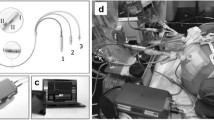Summary.
Background: Continuous monitoring of intracranial pressure (ICP) still plays a key role in the management of patients at risk from intracranial hypertension. Numerous ICP-measuring devices are available. The aim of the present study was to investigate the clinical characteristics and the magnetic resonance imaging (MRI) compatibility of the recently developed Neurovent-P® (REHAU AG+CO, REHAU, Germany) ICP monitoring device.
Method: In a prospective two-center study, a total of 98 patients with severe head injury, subarachnoid haemorrhage, intracerebral haemorrhage, and non-traumatic brain edema underwent intraparenchymal monitoring of ICP using the Neurovent-P®. A control group comprising 50 patients underwent implantation of the Camino®-OLM-110-4B ICP monitor. The zero drift of the probes was determined before and after the ICP recording period. Technical and medical complications were documented. The MRI compatibility of the Neurovent-P® ICP probe was investigated by evaluating artifacts caused by the probe, probe function and temperature changes during MRI, and probe movement caused by the magnetic field.
Findings: The mean zero drift was 0.2±0.41 mmHg (maximum 3 mmHg) for the Neurovent-P® ICP probes and 0.4±0.57 mmHg (maximum 12 mmHg) for the Camino®-OLM-110-4B ICP probes. No significant correlation was identified between the extent of zero drift following the removal of the probes and the length of monitoring. Intraparenchymal haemorrhage spatially related to the probe occurred in 1 out of 50 (2%) patients with a Camino®-OLM-110-4B probe and in 1 out of 98 (1%) with a Neurovent-P®. Damage of the probe due to kinking or overextension of the cable or glass fiber occurred in 4 of the 50 (8%) Camino®-OLM-110-4B ICP probes and in 5 of the 98 (5%) Neurovent-P® probes.
On T2-weighted MR images, the Neurovent-P® ICP probe induced only small artifacts with very good discrimination of the surrounding tissue. On T1-weighted MR images, there was a good imaging quality but artifact-related local disturbances in signal occurred. There was no temperature change in the Neurovent-P® probe and in the surrounding brain tissue during MR imaging.
Interpretation: The Neurovent-P® ICP measuring system is a safe and reliable tool for ICP monitoring. Handling of the Neurovent-P® system is safe when performed properly.
Similar content being viewed by others
Author information
Authors and Affiliations
Additional information
Published online March 3, 2003
Correspondence: Ruediger Stendel, M.D., Department of Neurosurgery, Benjamin Franklin Medical Center, Free University of Berlin, Hindenburgdamm 30, 12203 Berlin, Germany.
Rights and permissions
About this article
Cite this article
Stendel, R., Heidenreich, J., Schilling, A. et al. Clinical evaluation of a new intracranial pressure monitoring device. Acta Neurochir (Wien) 145, 185–193 (2003). https://doi.org/10.1007/s00701-002-1052-0
Issue Date:
DOI: https://doi.org/10.1007/s00701-002-1052-0




